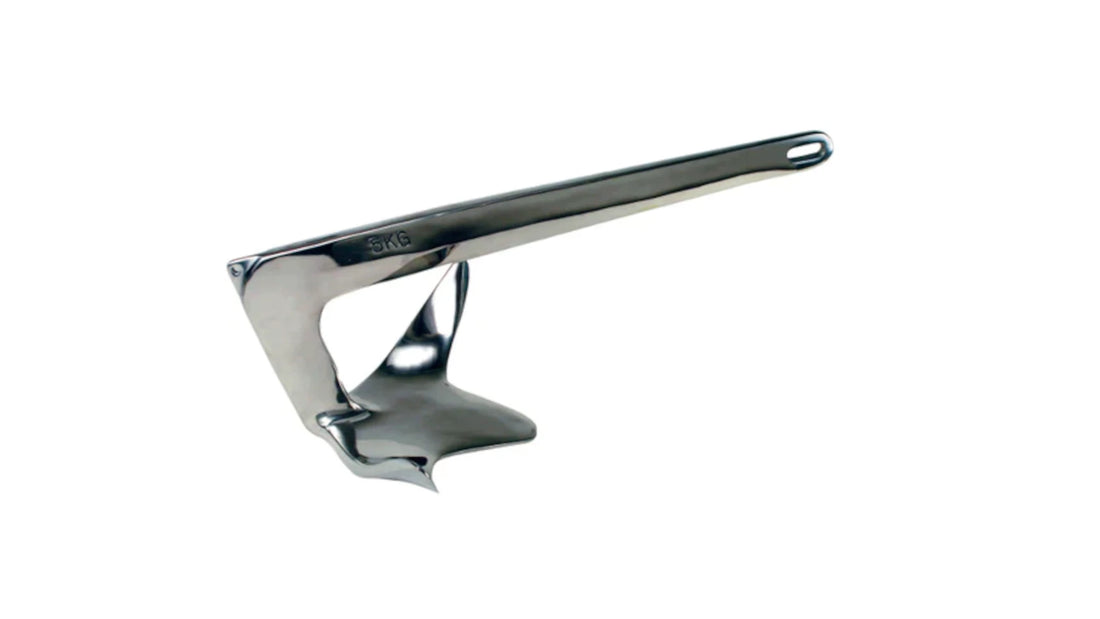Choosing the right anchor is not always easy. There are many different models and what are the differences? We will tell you a little about the anchors we sell and why you should choose one or the other.
MAXANARE / BRUCE ANCHOR

Dear child has many names and this plow anchor is one of the most popular anchor among recreational boat owners. This anchor was developed in the United States in the 70's by the Bruce Anchor Group. When their patents expired in the early 2000s, they shut down manufacturing. Instead, many imitations began to pop up in the market and the model has since maintained its popularity.
Plow anchor is an excellent all-round anchor as it works well on most seabeds including mud, sand and rock. However, it is more difficult to penetrate hard surfaces such as mud and bottoms with heavy grass. The design with three claws in the plow makes it bite easier than other anchors. It comes off relatively easily if it gets stuck. A disadvantage of the Bruce anchor is that it has a lower holding force per kilo than other anchors, which means that you usually need a larger anchor than, for example, a Delta anchor.
Benefits: Works well in most conditions. Bites easily in the substrate.
Disadvantages: Relatively low holding force per kilo compared to other anchors.
Bottoms: Works well on most bottoms but a little less well on hard bottoms with clay or heavy grass.
See more: https : //www.seaside.nu/products/maxankare-galvat-stal
https://www.seaside.nu/products/maxankare-rostfritt-stal
PLOW ANCHOR / DELTA ANCHOR


This is another favorite among recreational boat owners. It has a holding force per kilo which is about 50% more than Max / Bruce anchors. Since the design and layout fits most anchor winches / anchor reels, it is an anchor that is fitted as standard by many boat manufacturers.
Benefits: Works well on most seabeds. Fits most scrolls.
Cons : May have difficulty biting in rocky bottoms.
Bottoms : Works well on most bottoms.
LEADED PLOW ANCHOR / CQR ANCHOR

Benefits : Works well in most bottoms. A good anchor for tidal differences.
Disadvantages: Hinge design can make stewing difficult. Relatively low holding force.
Bottoms: Works well in most bottoms; especially sand and clay.
BYGELANKARE

This is another variant of plow anchor. If you look more closely at this model, you will see that the plow part is much sharper than other plow anchors. Like a hot knife that cuts through butter, this anchor can cut into the seabed much more easily than other anchors. The support arch also helps to straighten the anchor when it has settled.
This anchor has performed extremely well in independent tests. The main disadvantage of these anchors is that because they are still patented, they can be comparatively expensive. The roll bar together with the elongated plow can also make it difficult to park these anchors on bow rollers.
Advantages : Very high holding force and ability to bite on the bottom.
Disadvantages : Difficult to use on anchor reels.
Bottoms : Works well in most bottoms.
FORTRESS / DANFORTH ANKARE


This anchor is probably the best of all when it comes to biting in mud and sand. Whether used as a main anchor or not, it is an excellent choice as a complementary or stern anchor.
Advantages: Works very well in clay and sand. Easily stored on most bow rolls.
Cons : Does not work well on rocky or grassy bottoms.
Bottoms : Clay and sand. Performs poorly in other bottoms.
DRAGG / SAVDRAGG / NÄTDRAGG



Drag is available in three models. The most common with a little pointed fly and saw pull with wide fly and the net pull with three fixed hooks. Tugs are commonly used for small boats, kayaks, dinghies, canoes, etc. Tugs are also popular with fishermen. It folds very compactly and is easy to stow. A drag's holding force comes by hooking on another object, such as a rock. Once it bites, it can create enormous holding force, which can also make it sometimes get stuck.
Pros: Perfect to use as a lunch hook. That it collapses gives a compact storage.
Disadvantages : Not suitable for long-term or permanent anchoring.
Bottoms: Rocky bottoms.
See more: https://www.seaside.nu/products/dragg-hopfallbart
https://www.seaside.nu/products/natdragg-250x8-mm
https://www.seaside.nu/products/sav-dragg-1-5-kg
PLATE ANCHOR / PLATE ANCHOR

Pros: Easy to handle and no sharp edges.
Disadvantages: Limited holding power.
Bottoms: Rocky bottoms.
See more: https://www.seaside.nu/products/galvaniserat-tallriksankare-3-kg
MUSHROOM ANCHOR

Large sponge anchors are often used for permanent mooring buoys. When mud from the seabed builds up over these anchors, it can result in extreme holding force, up to 10 times the holding force of its actual weight. The smaller model of 4.5 kg that we sell is excellent as a dinghy mooring as it is easy to handle for both large and small sailors. A perfect choice for a temporary mooring.
Benefits: The plastic coating protects the rubber, gelcoat and narrow legs.
Disadvantages: Limited holding power.
Bottoms: Soft sand and clay.
See more: ttps: //www.seaside.nu/products/ankare-4-5kg-svamp-gummikladd
MATERIAL CHOICE
Finally, we also want to say something about the choice of material for your anchor. They are available in galvanized or stainless steel. The galvanization is to prevent rust and other corrosion on a steel anchor. But galvanizing has a tendency to wear down over time, and an anchor can be galvanized. But there is hardly anyone doing as these anchors are quite cheap.Stainless steel is identical to galvanized steel in terms of durability but differs markedly in appearance. The glossy luster is basically the only difference between stainless steel and galvanized steel. Stainless steel is also very corrosion resistant and will withstand most of the rust over time. There are manufacturers who describe stainless steel as either 316 stainless or 304 stainless. 316 has a different chemical composition than 304 and is more corrosion resistant. Under certain conditions, stainless steel anchors can bite better than galvanized anchors.

